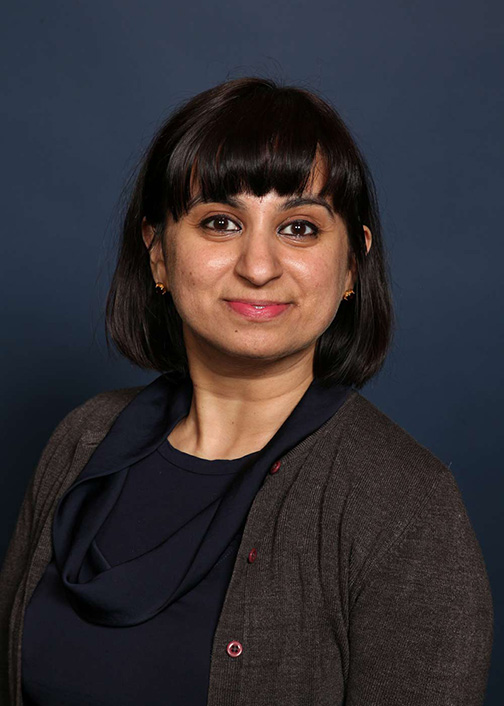Utthara Nayar Joins BMB Faculty

Utthara Nayar’s first day as an assistant professor this January was the culmination of many years of anticipation, but the pandemic made for an unusual start.
“I always imagined on my first day I would swing by all my colleagues’ offices and knock on their doors and say ‘Hi,’ and that wasn’t really an option,” laughed Nayar, PhD.
Nayar is the second of three new assistant professors to join BMB this academic year.
“Utthara brings her energy and enthusiasm for teaching as well as her expertise in genomics, and systems biology to BMB, which will add tremendously to our existing research efforts,” said Ashi Weeraratna, PhD, chair of the Department. “Her work on breast cancer will also have important facets of minority health research disparities, and I look forward to having her engage in community outreach public health efforts.”
Nayar said that she’s excited to be part of BMB because of its breadth, and depth, of research. After working in cancer-centric institutions for years, she’s glad to be immersed in a basic biology-focused department. She pointed to her first BMB seminar as an example of why: it was on structural biology, a subject she hadn’t attended a seminar on for many years, and immediately provided a new angle she hopes to pursue in her research.
Along with her love of basic biology, she’s driven by the translational impact of research. In fact, her quest for understanding breast cancer led Nayar not just to her current projects, but research in general.
As an 18-year-old pre-med student, she lost one aunt to breast cancer, while around the same time a second aunt was diagnosed and survived.
“At that moment I was very much motivated by that realization—if it’s possible to survive, if cancer is not a death sentence, then how do you understand that phenomenon better? And how do you make sure everybody survives?” Nayar explained.
Breast cancer recently became the most common cancer globally. Treatment of early-stage breast cancer has advanced significantly in the last few decades, due in part to the widespread use of tamoxifen, which targets the estrogen receptor, a driver of breast cancer. However, Nayar explained, 40,000 breast cancer patients still die each year in the U.S., mostly due to endocrine resistance, when tumors are resistant to tamoxifen and related ER-targeting drugs. Nayar aims to understand the biological mechanisms behind that resistance.
“Dr. Nayar identified activating HER2 mutations as underlying resistance to anti-estrogen receptor drugs in ER-positive breast cancer during her time at Harvard,” said Weeraratna. “Her research plan builds on her work on endocrine therapy resistance to identify new therapeutic vulnerabilities, and is a natural fit with the Breast Cancer Program at the Sidney Kimmel Comprehensive Cancer Center.”
Nayar found this mechanism through whole exome sequencing of paired breast cancer tumors, before and after the acquisition of resistance to ER therapy. At the time, the only known ER therapy resistance mechanism in patients was though mutations in ER itself, but her research and others’ indicate that mutations in HER2 and related molecules may account for up to 15% of endocrine resistance in metastatic breast cancer.
Nayar aims to answer three big questions in her lab: First, how tumors acquire resistance; second, what mechanisms drive resistance at the molecular level; and third, what vulnerabilities resistant tumors have that can be targeted therapeutically.
A longer-term goal is to work on breast cancer types that are more common in populations that are currently underrepresented in genomic data sets. Nayar sees diversity and inclusion as important to ensuring that science reaches everyone and benefits all populations, and in training the next generation of scientists. She joined the Department’s Diversity and Inclusion Committee even before officially starting and was part of the equivalent committee at the Broad Institute of MIT and Harvard.
With Nayar’s combined interest in basic biology and its potential health impacts, the department’s unique position in a school of public health was another draw. “I was excited at the opportunity to interact with public heath scientists like epidemiologists and health services researchers because I think the population-level impact is a critical perspective to keep in mind as a wet-lab researcher.”
Mentorship is one of Nayar’s favorite aspects of academic science. When three MHS students approached her about doing rotations in December before she officially started, she developed virtual rotations that allowed the students to do meaningful research remotely. She is now hosting her first BMB PhD student in what she calls a banner moment for her new lab.
Prior to joining BMB, Nayar was a postdoctoral fellow at the Dana-Farber Cancer Institute, Harvard Medical School, and the Broad Institute of MIT and Harvard.
